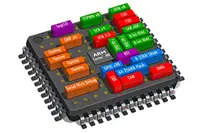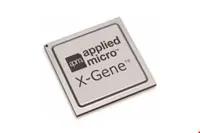Electronics News
Archive : 26 January 2016 год
 Cypress Semiconductor has introduced the latest series from its PSoC 4 programmable system-on-chip architecture. The PSoC 4 L-Series is said to be the industry’s most integrated single-chip solution with a 32-bit ARM-Cortex-M0 core, featuring up to 256KBytes flash memory, 98 general purpose I/Os, 33 programmable analogue and digital blocks, a USB device controller, and a control area network interface.
Cypress Semiconductor has introduced the latest series from its PSoC 4 programmable system-on-chip architecture. The PSoC 4 L-Series is said to be the industry’s most integrated single-chip solution with a 32-bit ARM-Cortex-M0 core, featuring up to 256KBytes flash memory, 98 general purpose I/Os, 33 programmable analogue and digital blocks, a USB device controller, and a control area network interface.
The PSoC 4 L-Series is suited for industrial and consumer applications, leveraging the flexibility of the PSoC architecture to address multiple product variations and Cypress’s CapSense capacitive touch-sensing technology to implement reliable and elegant user interfaces.
John Weil, vice president of MCU marketing at Cypress, said: “The PSoC 4 L-Series introduces capabilities such as dual-mutual CapSense blocks with up to 94 channels for large, capacitive-touch home appliance applications and USB and programmable digital blocks to create bit-perfect digital audio solutions. Additionally, it provides all the resources needed to create new products for the emerging USB Type-C market.”
The PSoC 4 L-Series delivers up to 13 programmable analogue blocks including four high-performance opamps, four current-output digital-to-analogue converters, two low-power comparators, a 12-bit SAR ADC and dual CapSense blocks with up to 94 capacitive-sensing channels. The programmable analogue blocks are said to enable engineers to create on-chip, custom analogue front ends to support end-product features, without increasing product costs, size or power consumption.
The PSoC 4 L-Series delivers up to 20 programmable digital blocks including eight timer/counter/PWM blocks, four serial communication blocks and eight Universal Digital Blocks (UDBs). UDBs can be configured as coprocessors to offload compute-intensive tasks from the ARM Cortex-M0 core. The blocks are also said to enable engineers to implement custom digital peripherals, state machines or glue logic.
The PSoC 4 architecture is complemented by the PSoC Creator Integrated Design Environment (IDE), which is claimed to simplify system design and accelerates time-to-market by enabling concurrent hardware and firmware design.
The PSoC 4 L-Series will be available in 48-pin TQFP, 64-pin TQFP, 68-pin QFN and 124-pin VFBGA packages.
Author
Tom Austin-Morgan
Source: www.newelectronics.co.uk
 A three year €4.8million European project due to set off in February 2016 will use AppliedMicro’s X-Gene technology to develop a universal system architecture and software ecosystem for servers.
A three year €4.8million European project due to set off in February 2016 will use AppliedMicro’s X-Gene technology to develop a universal system architecture and software ecosystem for servers.
As part of the UniServer project, AppliedMicro will develop custom platforms based on X-Gene that address the complexities associated with Big Data and IoT applications.
“The goal of UniServer is to improve the energy efficiency, performance, dependability and security of microservers and AppliedMicro quickly emerged as the platform of choice for this research,” said Queen’s University Belfast researcher Dr Georgios Karakonstantis, project coordinator.
Paramesh Gopi, AppliedMicro’s president and CEO, added: “The pervasiveness and proven ability of the X-Gene platform complements the goal of the UniServer project to improve the performance of servers that run internet and cloud-based services, while reducing design, implementation costs and power consumption.”
Other members of the UniServer consortium include ARM and IBM.
Author
Graham Pitcher
Source: www.newelectronics.co.uk
 With NXP’s acquisition of Freescale now complete – a deal which valued the latter at $11.8billion – the new, enlarged company disclosed at an event in Paris how it would be looking to address high growth opportunities in the ‘smarter world’, with target areas including the smart home, industry, healthcare and wearables.
With NXP’s acquisition of Freescale now complete – a deal which valued the latter at $11.8billion – the new, enlarged company disclosed at an event in Paris how it would be looking to address high growth opportunities in the ‘smarter world’, with target areas including the smart home, industry, healthcare and wearables.
The new company, which is now the fourth largest semiconductor business in the world, will be focusing on high performance mixed signal solutions and has been structured around five key business units: security and connectivity; automotive; RF; standard products; and digital networking.
Speaking in Paris, Geoff Lees, general manager of NXP’s MCU business, said there was ‘little overlap between the two companies’ portfolios’, adding the new business was well placed to offer processors, security and software across the Internet of Things, ‘whether for the consumer, industrial, medical of automotive sectors’.
Both companies have significant positions in the industrial and automotive markets and will now, according to Lees, be better placed to develop their presence in the burgeoning market for IoT chips, where low margins mean that economies of scale will be essential if companies are to compete effectively.
A key element of the merger is the strength both companies have traditionally had in the automotive sector.
“The connected car took centre stage at this year’s Consumer Electronics Show,” suggested Lees, “highlighting the importance of both security and connectivity across the network. NXP can offer capabilities to this market from design through to effective infrastructure management.”
Maurice Gereats, senior director, new business, agreed. “NXP is number one in terms of infotainment and security and in in-vehicle networks, while Freescale has been able to bring to the new company a strong presence in safety, such as ABS, and in body electronics.
“Our presence in body electronics, safety, infotainment, networking and security means that NXP is now well placed in what is a fast developing market for secure connected vehicles.”
Lees suggested the company would be focused on bringing product to market more quickly and, when asked whether he felt the new business would be focusing more on research than had been the case in the past, he pointed to the company’s work with Samsung and the development of fully depleted silicon on insulator (FD-SOI) technology.
According to NXP, it expects to make savings of $200million in the first full year, rising to $500m. Whilst significant, they are seen to be relatively modest for a deal of this size.
Meanwhile, rumours are circulating suggesting possible layoffs. “These will most likely in our respective back offices,” according to Lees, but it is unlikely the company will embark on significant layoffs.
Recently, Freescale closed its R&D centre in Israel, with the loss of 200 engineers and there have been suggestions of layoffs in Malaysia and Texas – but as yet nothing has been confirmed.
Lees said the newly combined company would have around 11,500 engineers. “That is a significant engineering presence and they will be key to unlocking the challenges we face and delivering solutions we need going forward, whether in terms of security or connectivity.”
As part of the Paris event, a mobile truck loaded with displays demonstrating the new company’s technologies and capabilities was parked outside the venue. Similar trucks are deployed in the US and China. The vehicle will be used at events around Europe and, next month, will be seen at Embedded World in Nuremberg.
Pic: Loaded with technology displays, NXP used this truck to demonstrate the capabilities of the new business
Author
Neil Tyler
Source: www.newelectronics.co.uk

